I've been handed a task to improve query performance on a table.
The primary key is a GUID that is created by application code, so is not sequential, and there is no separate sequential clustering key on the table.
My feeling is that it is the choice of a non-sequential GUID as the primary and clustering key that is the main culprit for poor performance. I intend to drop the clustered index on the GUID and add an INT IDENTITY as the clustering key.
The table has ~3 million rows in it.
Is it better to try and alter the table, or to create a new table, copy the existing data to it, remove the old table, and rename the new table?
EDIT: Copying 3 million rows is taking a very long time. Would dropping the index be quicker?
EDIT 2: Decided to solve the slow copying problem with hardware, and threw 20 cores at it instead of 4. It's a lot quicker now, though still far slower than i'd expect. I'd estimate it will take 30 minutes to copy the 3 million rows.
Would still appreciate a solution though as this is just a test, i still have to do it on the production server, i'd i'd rather not have it down for longer than necessary.
For info, based on advice by @ughai, my autogrowth settings are now at 500Mb.
This kind of thing is not really my specialty so would appreciate some advice as to what is the best way of going around this.
If it's relevant, the bulk of the queries that take place on this table have no joins.
EDIT: Original Table Schema
CREATE TABLE [dbo].[IODBTaskHistory](
[Id] [uniqueidentifier] NOT NULL,
[Tag] [nvarchar](250) NULL,
[Type] [int] NOT NULL,
[SourceFilePath] [nvarchar](max) NOT NULL,
[DestinationFilePath] [nvarchar](max) NULL,
[Priority] [int] NOT NULL,
[State] [int] NOT NULL,
[SubState] [int] NOT NULL,
[StateDescription] [nvarchar](max) NULL,
[Progress] [decimal](5, 2) NOT NULL,
[Date_Created] [datetime] NOT NULL,
[Date_Queued] [datetime] NULL,
[Date_Started] [datetime] NULL,
[Date_Finished] [datetime] NULL,
[Date_LastUpdated] [datetime] NULL,
[Optional_ParentDependancyTaskId] [uniqueidentifier] NULL,
[Optional_isParentSuccessRequired] [bit] NULL,
[Transfer_ProgressBytes] [float] NULL,
[Transfer_SpeedCurrentBps] [float] NULL,
[Transfer_SpeedIntervals] [nvarchar](max) NULL,
[IODrone_Id] [uniqueidentifier] NULL,
[IODrone_Version] [nvarchar](max) NULL,
[Action] [int] NOT NULL,
[Date_TransferStarted] [datetime] NULL,
[Optional_NotificationEmails] [nvarchar](max) NULL,
[MaxRetryCount] [int] NULL,
[CurrentRetryCount] [int] NULL,
[Impersonation_Username] [nvarchar](200) NOT NULL,
[Impersonation_Password] [nvarchar](max) NOT NULL,
[AllowRewrite] [bit] NOT NULL CONSTRAINT [DF_IODBTaskHistory_AllowRewrite] DEFAULT ((0)),
[SubTag] [nvarchar](255) NULL,
[SourceLengthBytes] [bigint] NULL CONSTRAINT [DF_IODBTaskHistory_SourceLengthBytes2] DEFAULT ((0)),
[IODrone_Thread] [int] NULL,
[Date_FileSizeFetched] [datetime] NULL,
[Date_StornextTapeRetrievalStarted] [datetime] NULL,
[Date_StornextTapeRetrievalFinished] [datetime] NULL,
[IOServiceAddress] [nvarchar](20) NULL,
[LogString] [nvarchar](max) NULL,
[NotesString] [nvarchar](max) NULL,
[TX_Date] [datetime] NULL,
[SlowDownUpload] [bit] NULL CONSTRAINT [DF_IODBTaskHistory_SlowDownUpload] DEFAULT ((0)),
CONSTRAINT [PK_IODBTaskHistory] PRIMARY KEY CLUSTERED
(
[Id] ASC
)WITH (PAD_INDEX = OFF, STATISTICS_NORECOMPUTE = OFF, IGNORE_DUP_KEY = OFF, ALLOW_ROW_LOCKS = ON, ALLOW_PAGE_LOCKS = ON) ON [PRIMARY]
) ON [PRIMARY] TEXTIMAGE_ON [PRIMARY]
Destination Table Schema
CREATE TABLE [dbo].[IODBTaskHistoryNew](
[Id] [uniqueidentifier] NOT NULL,
[ClusterKey] [int] IDENTITY(1,1) NOT NULL,
[Tag] [nvarchar](250) NULL,
[Type] [int] NOT NULL,
[SourceFilePath] [nvarchar](max) NOT NULL,
[DestinationFilePath] [nvarchar](max) NULL,
[Priority] [int] NOT NULL,
[State] [int] NOT NULL,
[SubState] [int] NOT NULL,
[StateDescription] [nvarchar](max) NULL,
[Progress] [decimal](5, 2) NOT NULL,
[Date_Created] [datetime] NOT NULL,
[Date_Queued] [datetime] NULL,
[Date_Started] [datetime] NULL,
[Date_Finished] [datetime] NULL,
[Date_LastUpdated] [datetime] NULL,
[Optional_ParentDependancyTaskId] [uniqueidentifier] NULL,
[Optional_isParentSuccessRequired] [bit] NULL,
[Transfer_ProgressBytes] [float] NULL,
[Transfer_SpeedCurrentBps] [float] NULL,
[Transfer_SpeedIntervals] [nvarchar](max) NULL,
[IODrone_Id] [uniqueidentifier] NULL,
[IODrone_Version] [nvarchar](max) NULL,
[Action] [int] NOT NULL,
[Date_TransferStarted] [datetime] NULL,
[Optional_NotificationEmails] [nvarchar](max) NULL,
[MaxRetryCount] [int] NULL,
[CurrentRetryCount] [int] NULL,
[Impersonation_Username] [nvarchar](200) NOT NULL,
[Impersonation_Password] [nvarchar](max) NOT NULL,
[AllowRewrite] [bit] NOT NULL,
[SubTag] [nvarchar](255) NULL,
[SourceLengthBytes] [bigint] NULL,
[IODrone_Thread] [int] NULL,
[Date_FileSizeFetched] [datetime] NULL,
[Date_StornextTapeRetrievalStarted] [datetime] NULL,
[Date_StornextTapeRetrievalFinished] [datetime] NULL,
[IOServiceAddress] [nvarchar](20) NULL,
[LogString] [nvarchar](max) NULL,
[NotesString] [nvarchar](max) NULL,
[TX_Date] [datetime] NULL,
[SlowDownUpload] [bit] NULL,
PRIMARY KEY NONCLUSTERED
(
[Id] ASC
)WITH (PAD_INDEX = OFF, STATISTICS_NORECOMPUTE = OFF, IGNORE_DUP_KEY = OFF, ALLOW_ROW_LOCKS = ON, ALLOW_PAGE_LOCKS = ON) ON [PRIMARY],
UNIQUE CLUSTERED
(
[ClusterKey] ASC
)WITH (PAD_INDEX = OFF, STATISTICS_NORECOMPUTE = OFF, IGNORE_DUP_KEY = OFF, ALLOW_ROW_LOCKS = ON, ALLOW_PAGE_LOCKS = ON) ON [PRIMARY]
) ON [PRIMARY] TEXTIMAGE_ON [PRIMARY]
GO
ALTER TABLE [dbo].[IODBTaskHistoryNew] ADD CONSTRAINT [DF_IODBTaskHistory_AllowRewriteNew] DEFAULT ((0)) FOR [AllowRewrite]
GO
ALTER TABLE [dbo].[IODBTaskHistoryNew] ADD CONSTRAINT [DF_IODBTaskHistory_SourceLengthBytes2New] DEFAULT ((0)) FOR [SourceLengthBytes]
GO
ALTER TABLE [dbo].[IODBTaskHistoryNew] ADD CONSTRAINT [DF_IODBTaskHistory_SlowDownUploadNew] DEFAULT ((0)) FOR [SlowDownUpload]
GO
MY Copy query
INSERT INTO [dbo].[IODBTaskHistoryNew]
([Id]
,[Tag]
,[Type]
,[SourceFilePath]
,[DestinationFilePath]
,[Priority]
,[State]
,[SubState]
,[StateDescription]
,[Progress]
,[Date_Created]
,[Date_Queued]
,[Date_Started]
,[Date_Finished]
,[Date_LastUpdated]
,[Optional_ParentDependancyTaskId]
,[Optional_isParentSuccessRequired]
,[Transfer_ProgressBytes]
,[Transfer_SpeedCurrentBps]
,[Transfer_SpeedIntervals]
,[IODrone_Id]
,[IODrone_Version]
,[Action]
,[Date_TransferStarted]
,[Optional_NotificationEmails]
,[MaxRetryCount]
,[CurrentRetryCount]
,[Impersonation_Username]
,[Impersonation_Password]
,[AllowRewrite]
,[SubTag]
,[SourceLengthBytes]
,[IODrone_Thread]
,[Date_FileSizeFetched]
,[Date_StornextTapeRetrievalStarted]
,[Date_StornextTapeRetrievalFinished]
,[IOServiceAddress]
,[LogString]
,[NotesString]
,[TX_Date]
,[SlowDownUpload])
SELECT [Id]
,[Tag]
,[Type]
,[SourceFilePath]
,[DestinationFilePath]
,[Priority]
,[State]
,[SubState]
,[StateDescription]
,[Progress]
,[Date_Created]
,[Date_Queued]
,[Date_Started]
,[Date_Finished]
,[Date_LastUpdated]
,[Optional_ParentDependancyTaskId]
,[Optional_isParentSuccessRequired]
,[Transfer_ProgressBytes]
,[Transfer_SpeedCurrentBps]
,[Transfer_SpeedIntervals]
,[IODrone_Id]
,[IODrone_Version]
,[Action]
,[Date_TransferStarted]
,[Optional_NotificationEmails]
,[MaxRetryCount]
,[CurrentRetryCount]
,[Impersonation_Username]
,[Impersonation_Password]
,[AllowRewrite]
,[SubTag]
,[SourceLengthBytes]
,[IODrone_Thread]
,[Date_FileSizeFetched]
,[Date_StornextTapeRetrievalStarted]
,[Date_StornextTapeRetrievalFinished]
,[IOServiceAddress]
,[LogString]
,[NotesString]
,[TX_Date]
,[SlowDownUpload]
FROM [dbo].[IODBTaskHistory]
Execution Plan

If it's not clear form the picture 99% of the plan is spent on the clustered index insert on the new Identity column